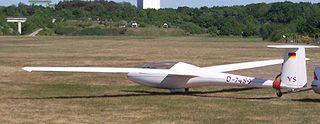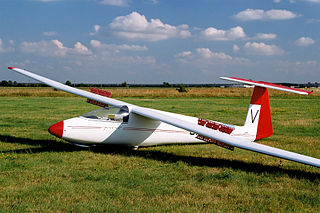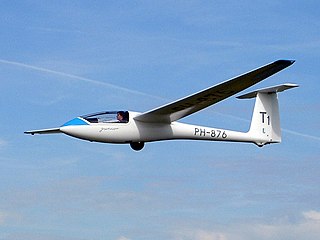
The ASK 13 is a two-seater glider that was built by German sailplane manufacturer Alexander Schleicher Gmbh & Co. It was and still is widely used for basic training of glider pilots.

The Politechnika Warszawska PW-5 Smyk is a single seater sailplane designed at the Warsaw University of Technology and manufactured in Poland. It is a monotype World Class glider.

The ASK 21 is a glass-reinforced plastic (GRP) two-seat glider aircraft with a T-tail. The ASK 21 is designed primarily for beginner instruction, but is also suitable for cross-country flying and aerobatic instruction.

The Schleicher K 8 is a single-seat glider designed by Rudolf Kaiser and built by the Alexander Schleicher company in Germany.

The Glasflügel 303 Mosquito is a composite 15 metre Class single-seat sailplane manufactured by Glasflügel between 1976 and 1980.

The PZL Bielsko SZD-50 Puchacz is a Polish two-place training and aerobatic sailplane.

The SZD-30 Pirat is a single-seat multipurpose glider aircraft from the Polish firm PZL Bielsko which first flew in 1966, and began production in 1967.

The ICA IS-28 is a two-seat sailplane produced in Romania in the 1970s. An all-metal aircraft of conventional design with a T-tail, it was originally produced with 15-metre wings, but in 1973, production shifted to the IS-28B with 17-metre wings and numerous aerodynamic refinements. These included a smaller tail with decreased dihedral, decreased dihedral on the wings, and redesigned fuselage contours. This version first flew on 26 April 1973 and was subsequently produced in versions with flaps (IS-28B2) and without (IS-28B1). Around 100 had been built by the early 1980s, with a substantial number sold for export. On April 7, 1979, Tom Knauff and R. Tawse set a world record with the IS-28 B2 glider, covering a distance of 829 kilometres on a predetermined out-and-return course from the Ridge Soaring Gliderport in Julian, Pennsylvania.
The SZD-25A Lis was a single-seat glider aircraft that was designed and built in Poland from 1955, derived from the SZD-16 Gil and SZD-25 Nov.

The Let L-33 Solo is a Czech shoulder-wing, single-seat, glider, designed by Marian Meciar and Vaclav Zajic, and produced by Let Kunovice. The L-33 first flew in 1992 and remained in production through 2012, supplied as a ready-to-fly aircraft.

The Schleicher Condor, also referred to as the Dittmar Condor, is a series of German high-wing, single and two-seat, gull winged, gliders that were designed by Heini Dittmar in the 1930s, produced in small quantities before the Second World War, produced again between 1952 and 1955 by Alexander Schleicher GmbH & Co and also by Ferdinand Schmetz.

The Politechnika Warszawska PW-2, also called the PW-2 Gapa, is a Polish lightweight high-wing, strut-braced single-seat, glider that was designed and built at the Warsaw University of Technology and also produced by DWLKK in the early 1990s. Total number of 19 gliders were built, including variant PW-2D bis.

The PZL Bielsko SZD-51 Junior is a Polish single-seat training and club sailplane.
The Roberts Cygnet is an American high-wing, cruciform tail, single-seat, glider that was designed and produced by Donald Roberts as a contender for the IGC World Class sailplane.

The Allstar SZD-54 Perkoz is a two-seater, glider for training, aerobatics, cross country flight and cloud flying from the Polish manufacturer Allstar PZL Glider. The sailplane has exchangeable wing tips for either 17.5 or 20 metres and is manufactured primarily from glass fibre reinforced plastic (GFRP). Without wing extension, it is certified for unlimited aerobatic manoeuvres. For glider training, the short wingspan is supplemented with winglets. As a cross-country glider with a 20 metres wing and winglets, the Perkoz has a glider index of 102. The SZD-54-2 Perkoz is the successor of the widely used SZD-50-3 Puchacz trainer, which is part of the SZD family of aircraft.

The PZL M-3 Pliszka (Wagtail) was the first all-metal Polish glider. Three were built but its performance, particularly its glide ratio, was not good enough for it to be produced for Polish clubs.
The Politechnika Warszawska PW-3 Bakcyl (Microbe) is a Polish primary glider developed from the PW-2 Gapa.

The Politechnika Warszawska PW-4 Pelikan was a motor-glider variant of the two seat Polish PW-3 Bakcyl glider. Only one flew.
The Schleicher AS 33 is a German glider manufactured by Alexander Schleicher. The prototype had its maiden flight from Huhnrain Airport, Poppenhausen near Frankfurt on 23 January 2020. The design can be flown in the 18 metre class or in the 15 metre class.















